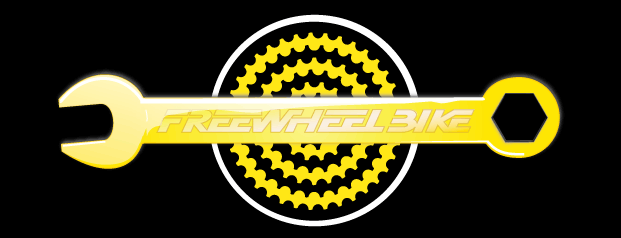In 1998 I bought a Diamondback V8. It was Richard Petty blue and red, with a Stratos shock on the back and a leaky first-generation SID on the front. It had first-generation SRAM ESP shifters, a super-short seatpost, and an awful WTB saddle, as well as a pair of Time ATAC pedals that I'm still using on one of my bikes. It came stock with XT cranks and tipped the scales at 24.8 pounds. By today's standards, it would still be a light, good-handling bike, and I put a few thousand miles on it over the course of the season.
By the end of the year, I had replaced the wheezing SID with a Manitou SX Ti, I had replaced three valves and ovalized the bushings on the Stratos shock, and I had cooked the bushings in the frame so that it went "URK-EEK" through its travel. The following season, for the above reasons, I rode a Bontrager Privateer. [fast forward sound]
Several years and a few steel hardtails later, I lost my inhibitions again and bought a 2003 Trek Fuel 98. Once again, I rode the thing into the ground, but this time it was my Alpha bike for three seasons. I wore out rocker links, beheaded pivot bolts, lost my lockout lever, toasted several sets of bushings, and popped half a score of early tubeless tires. This bike still sees some limited duty and still goes fast in the woods, but is now affectionately called "Mr. Sloppy" due to its handling characteristics.
I bought a Gunnar Ruffian single speed in 2006 and put the Trek away. Then I got a rigid fork. [fast forward sound]
Before Afton 2009 I did two laps of the race course with my beloved rigid fork and my wrists and shoulders said "that's it." They wrote me a long, sternly-worded manifesto in which they basically said that they felt they could do better elsewhere. In response, I dug out a 2003 Manitou Skareb that was serving a life sentence as spider habitat under my workbench. During the race, the fork, which had never seen any maintenance in its career, sprayed a bunch of oil out of the top seals onto nearby surfaces, such as me. Additionally, it was making weird noises, the lockout didn't work, and it felt kind of sticky. Off it came, and back under the bench it went, to the sustained applause of the spiders.
As I was gearing up to do Afton again this year, I remembered that suspension was a vital part of my campaign last year. Three laps with suspension was rough: there was no way I was going to do four laps without! The fork had not fixed itself, however, and the spiders have not been trained to work on Manitou stuff, so I had to do it. Grrrrrr..... I HATE WORKING ON MY OWN STUFF!!!!!
But, it turns out that fork service, while tedious (even Manitou admits this!), is good for your fork. It reminded me of the descriptions of veterinary surgery in James Herriott books. I managed to get most of it back together without dropping many of the pieces and without scorching anything with contaminating fluids. The old oil came out an opaque brown, the new went in a translucent purple. New bottom-out bushings replaced crumbly old ones. The old top seals that spewed oil on me were replaced with non-oil spewers. I also managed to dig most of the dirt (likely from Afton) out of the various nooks and crannies in the lower casting. Yup, it's lighter now.
When I was done, I gassed it up to 140 pounds and honched on it a few times on the floor. It made no slurping sounds, leaked no oil, and locked out dutifully. And it was smooth! On the bike, it was smoother! Yikes, it moves! This is how it's supposed to feel, apparently. I had never known it to feel as good as it did with fresh fluids and bits: I kept hitting things hard with my back wheel because I never felt them with the front wheel!
The service manual wants me to check the oil in the air piston every 6-8 weeks because the oil can "dissipate over time and then you may experience some air leakage and increased stiction in the fork movement." The manual also wants me to eat lots of vegetables and get plenty of sleep. Most manufacturers tell you to do some sort of regular maintenance every so often, usually based on ride time. For example, Halson required you to draft a haiku and read it to your fork once a fortnight. [Needless to say, this is the reason that Halson Inversion forks did not overwhelm the industry.]
Fork maintenance is a big deal! If you've been riding around on a sticky, leaky, slurpy, non-functioning fork, you've been missing out on performance. The fluids in there get contaminated and break down from heat. The soft bits deteriorate. The other bits crave attention and will become sullen if neglected.
Do yourself and your bike a favor and have this towering yeoman look at your fork.

His name is Tyson. He doesn't fit a 48cm road bike very well, but he has made suspension awesomeness his life's driving ambition.
Edit 6/23/10 2:40pm: After reading Chris' blog I decided to run a suspension service special. Our suspension service packages are $10 off now through June 30th or you can win a suspension fork tune-up (labor only, you have to pay for parts) by being the first person to email the correct answer to the following trivia question to peteh@freewheelbike.com.
What unique design feature allowed Halson to use cantilever brakes on an inverted fork?
6/24/10 1:26pm We have a winner! The answer is that they had to make slots in the upper(outer) tubes for the cantilever bosses to slide up and down. Thanks to everyone for playing.
